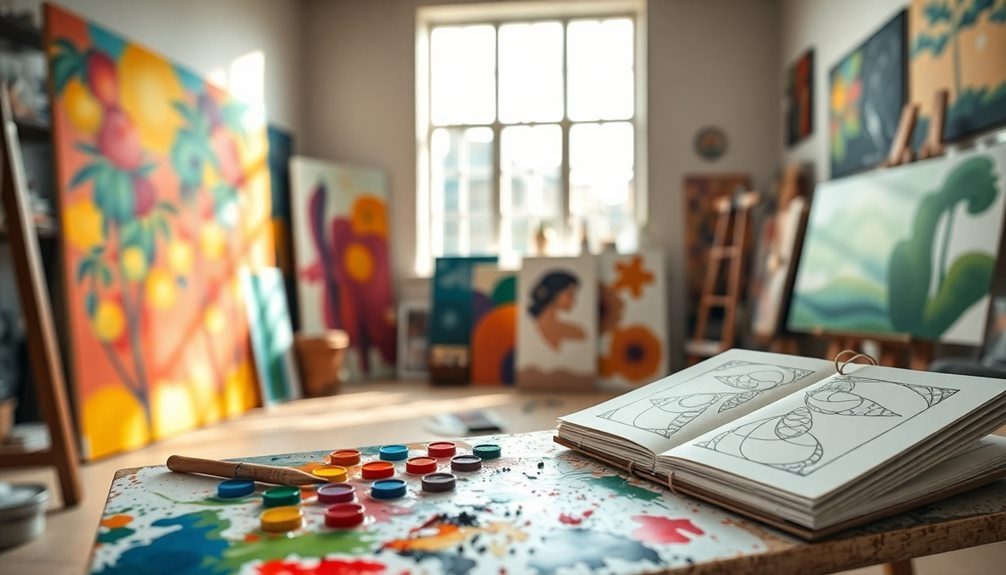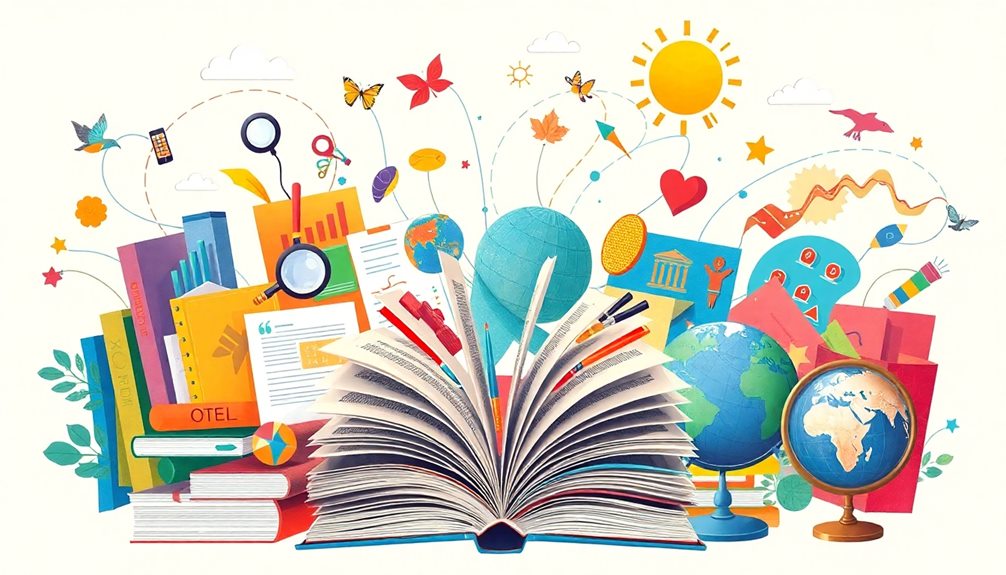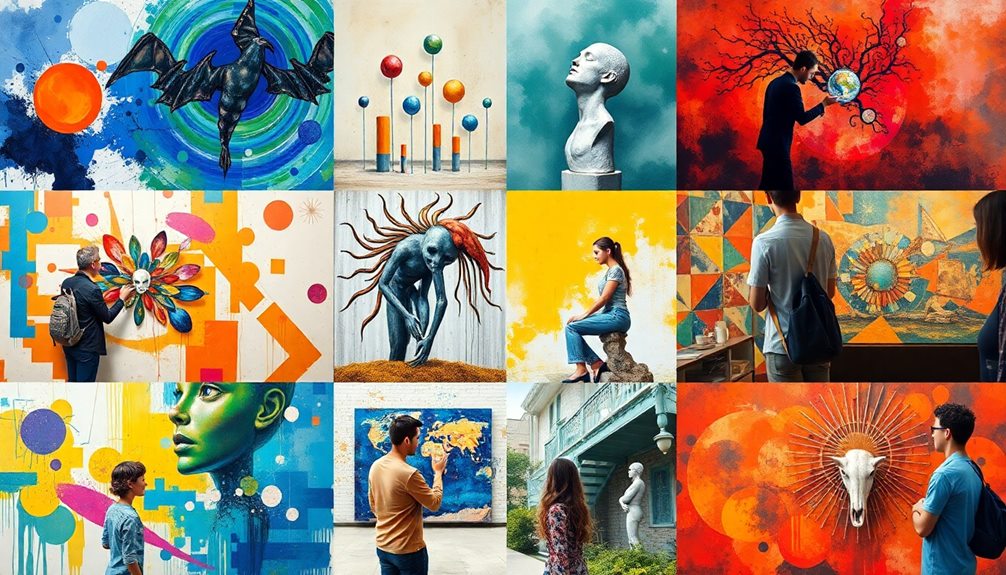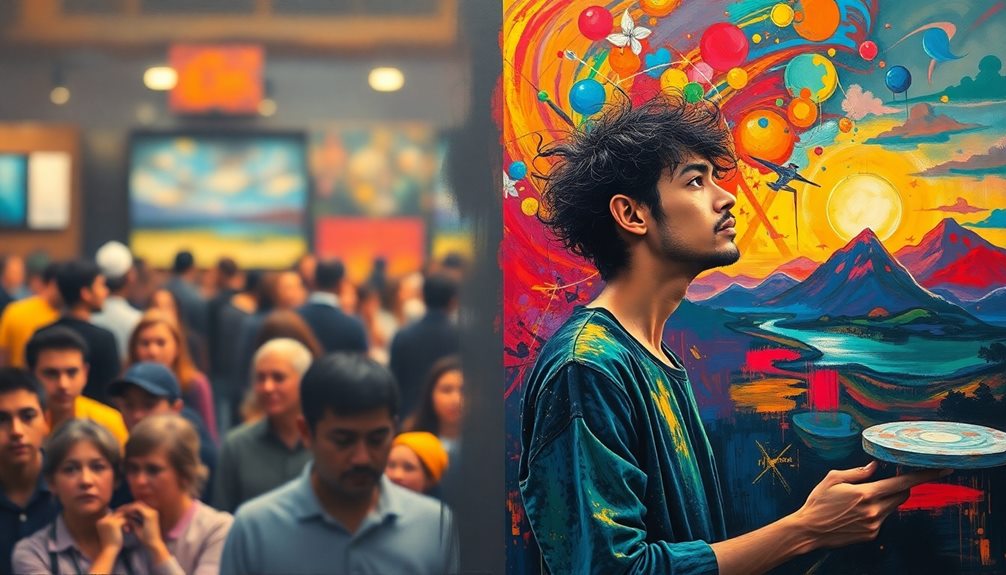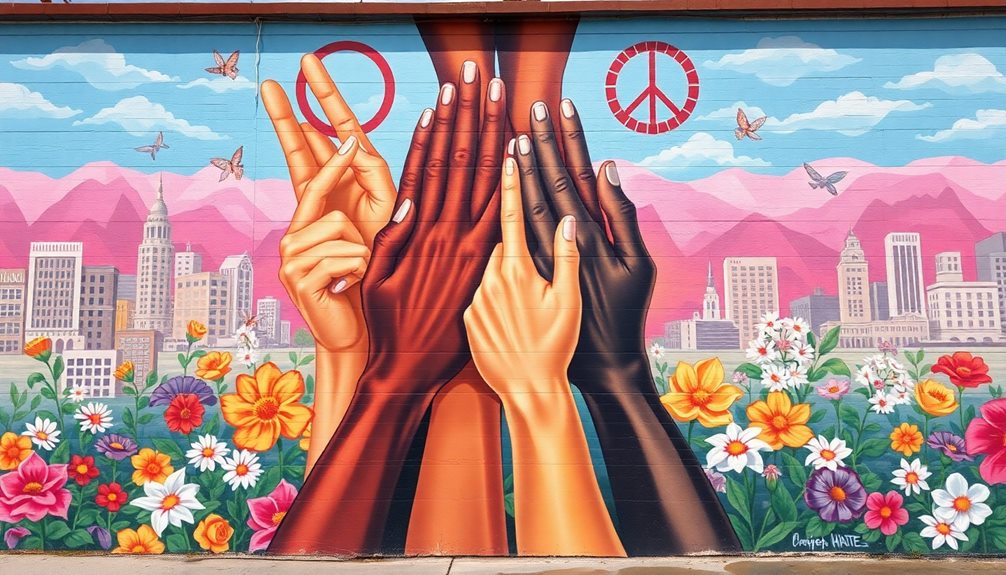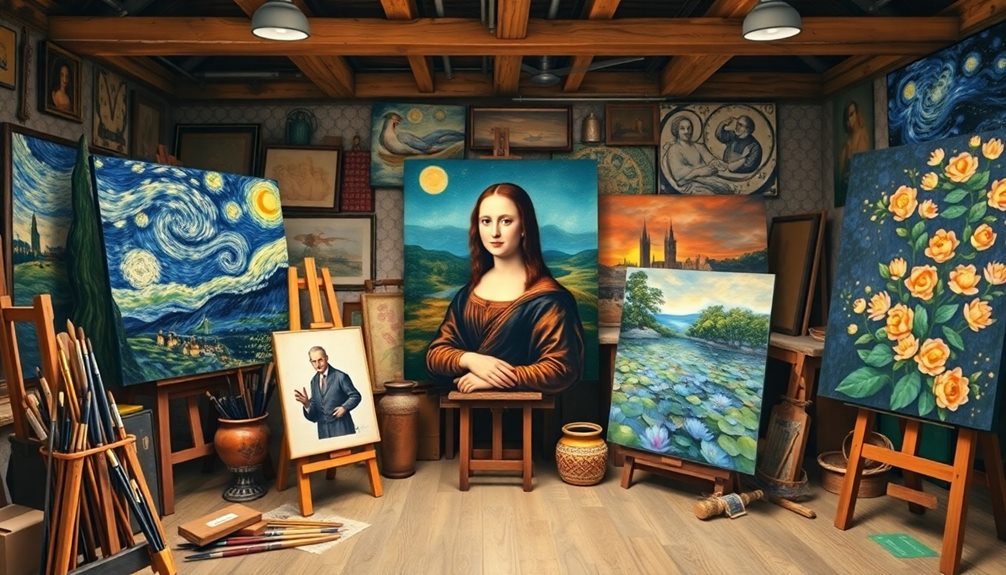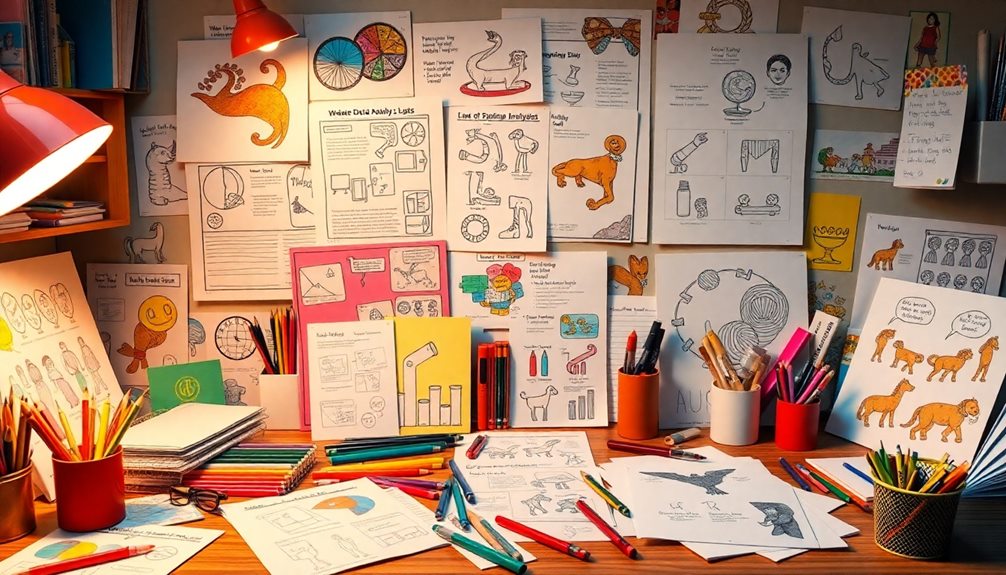To develop your eye for art, you need to practice focused observation regularly. Start by distinguishing between "looking" and "seeing"; deep observation reveals details, textures, and color relationships. Use techniques like squinting to simplify complex scenes and enhance negative space recognition. Familiarize yourself with color theory and the golden ratio to improve your compositions. Experiment with different art mediums to discover emotional responses. Engage with local galleries and workshops for experiential learning, and don't forget to seek feedback from peers. There's much more to explore in cultivating your artistic vision.
Key Takeaways
- Regularly practice observing colors, shapes, and textures to enhance your ability to "see" rather than just "look" at art.
- Use techniques like squinting to simplify complex scenes, helping you focus on compositions and negative space.
- Familiarize yourself with color theory to evoke emotions and refine your visual interpretation of artworks.
- Engage in exercises that differentiate between superficial observations and deeper insights to strengthen your artistic vision.
- Explore various art forms and styles to expand your understanding and appreciation of different techniques and perspectives.
Introduction
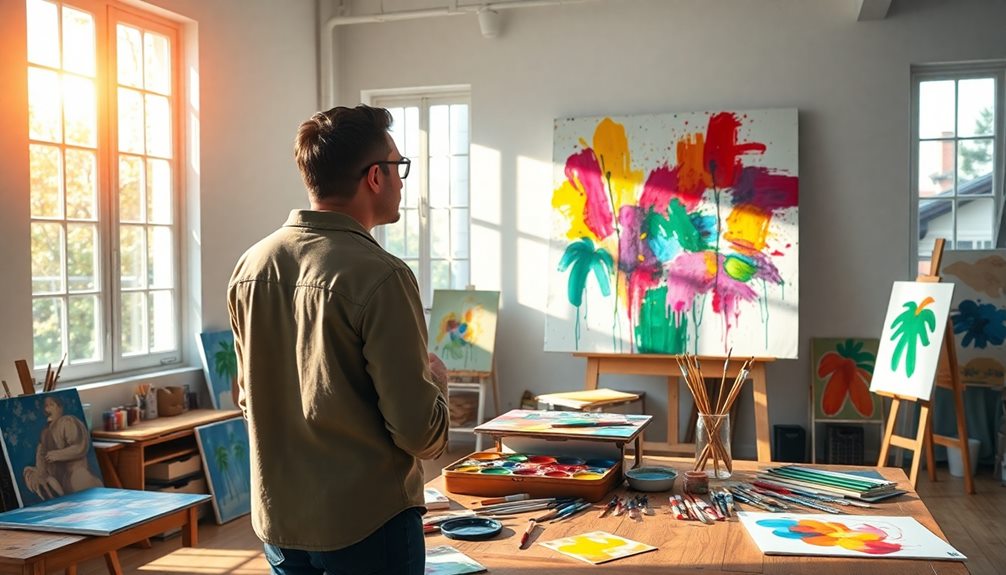
Art is a fascinating realm that invites you to look deeper. You might think seeing is simply a matter of glancing at a piece, but developing an Artist's Eye requires more. It's about training your brain to see beyond those initial observations. You'll want to focus on details, textures, and colors, and understand how all the elements in a composition relate to one another.
Regular practice is key. Engage in observation exercises that analyze light, shadow, and negative space. These elements enhance your ability to capture the essence of your subjects.
Try techniques like squinting to simplify complex scenes; this helps you perceive shapes and forms as cohesive masses rather than just a jumble of details.
Additionally, exploring color theory can significantly refine your skills. Understanding how color choices evoke emotions contributes to the overall mood of an artwork.
Don't overlook the value of learning from role models in the art world. Studying their techniques can inspire and inform your own artistic journey, making the process of learning to see both enjoyable and rewarding.
Key Concepts and Definitions
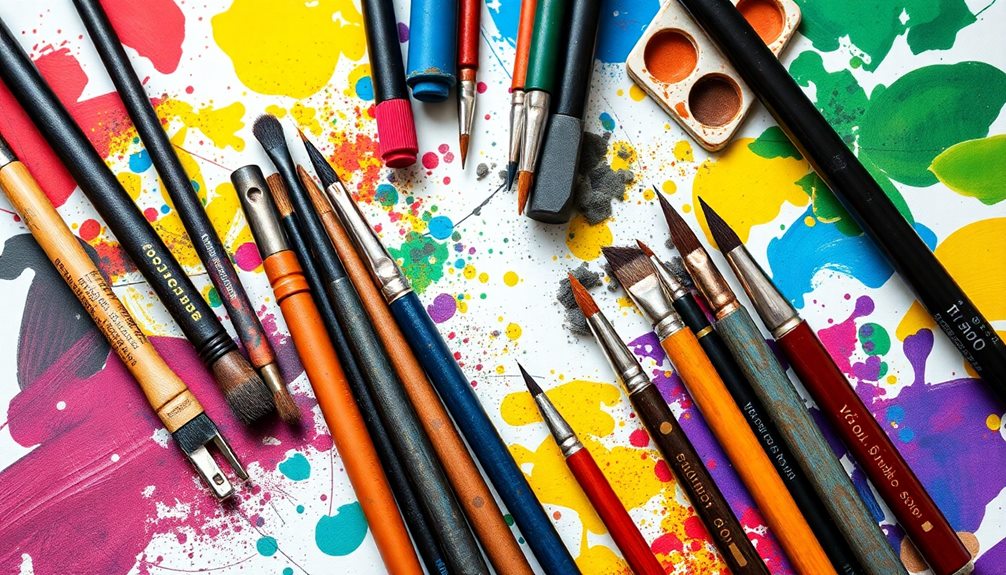
Recognizing key concepts and definitions is essential for honing your artistic eye. When you develop this eye, you learn to identify crucial elements like position, balance, color, shape, and compatibility within visual compositions.
It's important to understand the difference between "looking" and "seeing." True observation lets you connect seemingly unrelated elements, sparking your creativity. The difference between looking and seeing lies in the depth of your engagement. While looking is often passive, seeing requires intentionality and focus, allowing you to notice details others might overlook. By embracing the difference between looking and seeing, you can unlock new perspectives and generate ideas that are both innovative and meaningful.
One key concept is negative space, which refers to the area surrounding the main subjects in your artwork. This space plays a vital role in composition, often influencing the viewer's emotional response just as much as the subjects themselves.
To enhance your artistic skills, practice observation techniques, like squinting. This helps simplify complex scenes, allowing your eyes to see the essential components more clearly, leading to a deeper understanding of art.
Familiarizing yourself with the golden ratio (1.618) can also guide your compositions. It helps create dynamic and visually engaging artworks, making them more appealing to the viewer.
Visual Techniques for Artists

Developing your artistic eye lays the groundwork for mastering various visual techniques that can elevate your work. Start by training your eye to view the entire scene before zeroing in on the details. This approach helps you capture the essence of the artwork and informs your composition choices. Pay attention to environmental elements like lighting and context; they enhance the mood and depth of your subject.
One effective method is to simplify complex scenes by squinting. This technique allows you to see shapes and forms as masses rather than individual objects, aiding in your composition. Additionally, understanding negative space is crucial—recognizing the balance it provides contributes equally to your artwork's overall interest.
Regular practice in observing angles and lines can transform how you perceive arrangements. By guiding the viewer's eye, you create dynamic qualities in your pieces.
Mosaic Art From Fabric Scraps
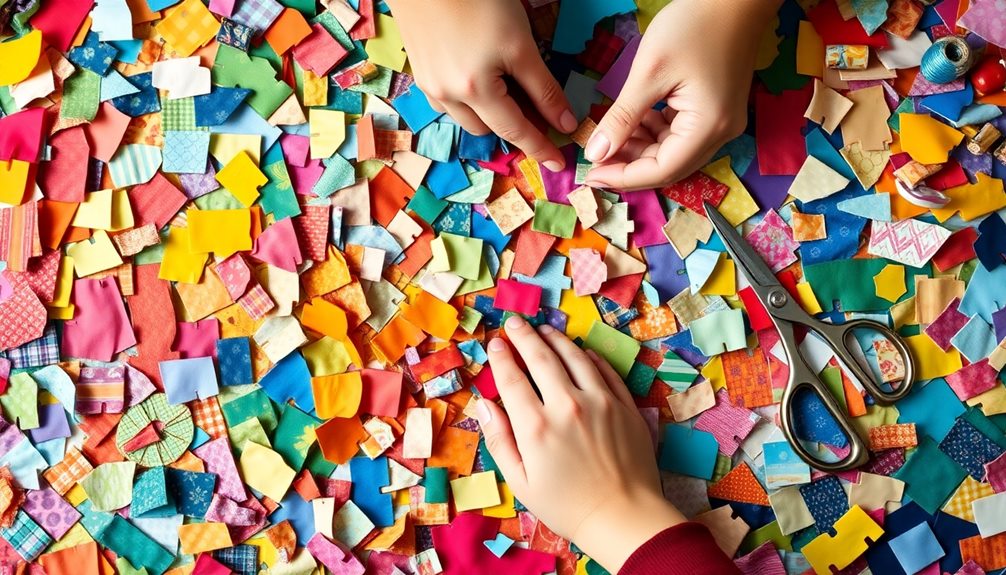
There's something magical about transforming fabric scraps into mosaic art. When you cut these scraps into various shapes and sizes, you open up a world of unique patterns that truly reflect your personal style.
To get started, you'll need scissors for cutting and an iron to flatten and adhere the pieces together, ensuring a polished finish. As you explore this creative process, consider incorporating elements of color theory and texture to elevate your artwork.
As you develop your skills, understanding color theory becomes crucial. Noticing things like harmonious color combinations can significantly enhance the visual appeal of your mosaic.
Experiment with different textures, combining soft cottons with shiny silks to add depth and interest to your artwork. This not only makes your piece more engaging but also invites viewers to explore the layers you've created.
Tips and Best Practices
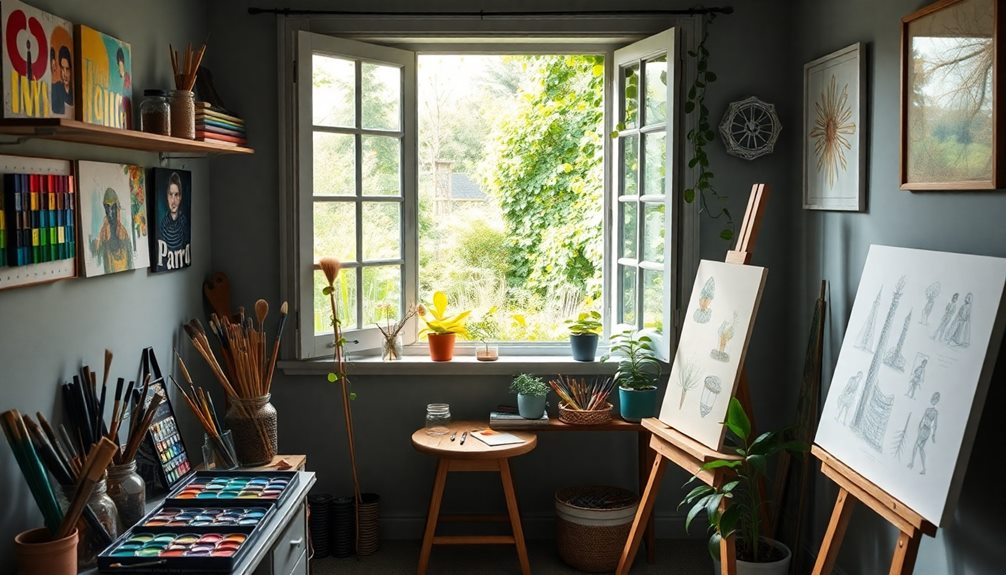
Artistic growth hinges on your ability to observe the world around you. Start by regularly practicing to notice colors, shapes, and textures in your surroundings. Engaging with art theory can provide foundational knowledge that enhances your observational skills. Pay attention to the details that often go unnoticed, as they can inspire your art.
Engage in exercises that differentiate between "looking" and "seeing." For example, try describing objects without naming them to foster a deeper connection with what you see.
Utilize techniques like squinting to simplify compositions. This helps you grasp the overall arrangement of objects and enhances your perception of negative space and shapes. Experiment with various mediums to study the impact of color and tonal value. Notice how different hues evoke emotional responses, making you more attuned to your artistic choices.
Creating an influence map can also sharpen your eye. Collect images and elements that resonate with you and reflect your aesthetic. This practice helps shape your personal artistic identity and vision.
Viewer Engagement and Feedback
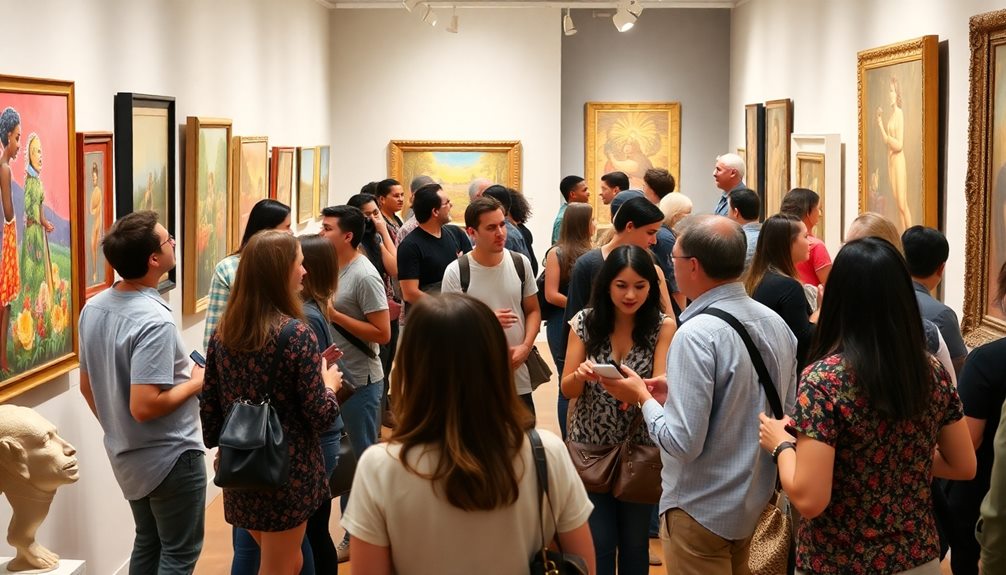
Engaging with your audience is just as important as honing your observational skills. When you create art that evokes emotional responses, you invite viewer engagement, allowing individuals to connect personally with your work. This connection prompts them to share their interpretations, enriching the overall dialogue surrounding your art.
Feedback from diverse audiences offers invaluable insights. It reveals how different cultural backgrounds and experiences shape perceptions of your creations. By utilizing social media platforms, you can share your artwork and receive real-time feedback, fostering discussions about your artistic choices and techniques.
Additionally, interactive elements like artist talks or workshops can deepen viewers' understanding and appreciation of your creative process. These experiences encourage them to engage more deeply, enhancing their emotional investment in your work.
Don't underestimate the value of constructive criticism from peers and mentors. Their perspectives can help you refine your work and elevate your artistic eye.
Embracing viewer engagement and feedback not only strengthens your connection with your audience but also enriches your development as an artist, making your journey all the more fulfilling.
Balancing Creativity With Constraints

Embracing constraints can actually spark your creativity in unexpected ways. When you limit your color palette or focus on specific themes, you force yourself to think outside the box. This innovation within boundaries can lead to stunning outcomes.
Establishing guidelines, like the golden ratio, helps you create a structured composition that maintains visual harmony while allowing for exploration.
Time limitations can be a powerful tool, too. They encourage quick decision-making and spontaneity, often resulting in fresh ideas you mightn't have explored otherwise.
Working with specific materials or techniques also challenges you, pushing you to adapt your vision and deepen your understanding of your craft.
As you balance creativity with constraints, you cultivate a disciplined artistic practice. This balance not only enhances your freedom of expression but also helps you develop a creative eye for the things around you.
You'll begin to notice how a shadow cast by an object can inspire a new perspective or technique in your art. Embrace these constraints, and watch your creativity flourish as you learn to navigate within them.
Additional Resources
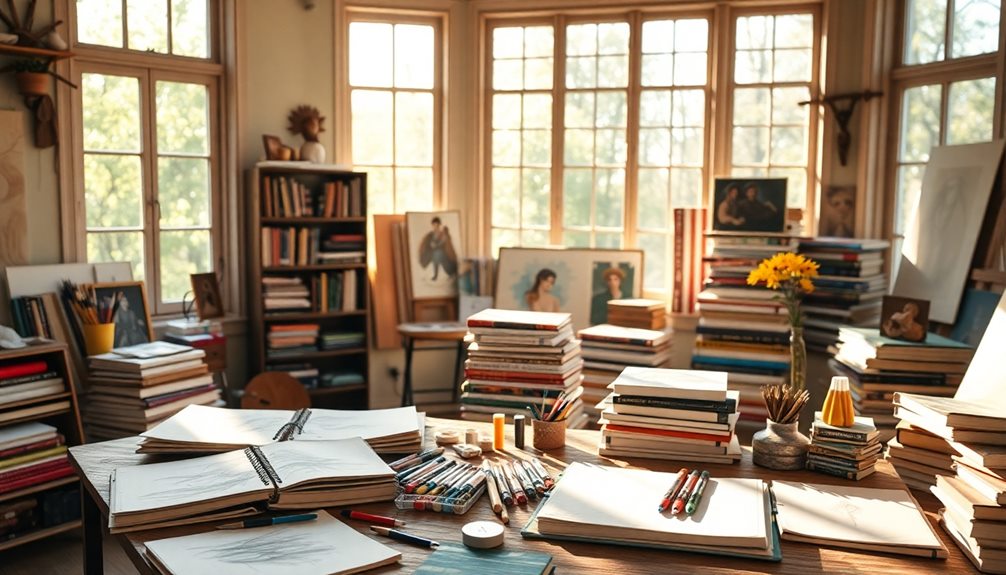
Building on the creativity you've developed through working within constraints, there are numerous resources available to enhance your artistic journey further.
Social media platforms like Pinterest and Instagram are fantastic places to look at things that inspire you, including Balinese interior design ideas that emphasize natural materials and earthy color palettes. You can discover diverse artistic styles and techniques that'll help you develop your own approach.
Consider exploring online courses or workshops that focus on observational drawing and color theory. These can deepen your understanding of the fundamentals and give you new insights as you create.
Reading books on art history or biographies of renowned artists also allows you to see something unique about their creative processes and the evolution of artistic movements.
Don't forget about art magazines and design blogs; they're great for analyzing current trends and innovative practices that can inform your eye for composition and aesthetics.
Finally, visiting local galleries and museums gives you firsthand experience with various artworks, fostering a more profound appreciation for different styles and mediums.
Frequently Asked Questions
How to Train Your Eyes for Drawing?
To train your eyes for drawing, practice observing shapes and proportions, squint to simplify scenes, focus on negative space, and engage in life drawing. These techniques sharpen your skills and enhance your visual accuracy over time.
How to Develop Your Artistic Vision?
To develop your artistic vision, immerse yourself in various art forms, practice observing details, and experiment with techniques. Explore color theories and embrace negative space to create balanced, impactful compositions that reflect your unique perspective.
How Does an Artist Train His Eye?
To train your eye, start by observing entire scenes, focusing on colors and tonal variations. Squint to simplify shapes, recognize negative space, and explore familiar subjects repeatedly to build a unique perspective for your art.
How to Train Your Eye for Design?
To train your eye for design, start by observing your surroundings closely. Notice colors, textures, and shapes. Engage with design content online, study renowned works, and practice simplifying scenes to enhance your design perception and skills.
Conclusion
In developing your eye for art, remember that practice and exploration are key. Embrace different techniques, like mosaic art, and don't shy away from experimenting with various materials. Engage with other viewers and artists to gather feedback, and balance your creativity with practical constraints. By continually honing your skills and staying open to new ideas, you'll cultivate a deeper appreciation for art and enhance your own artistic journey. Keep creating and observing—your eye will sharpen with time!
